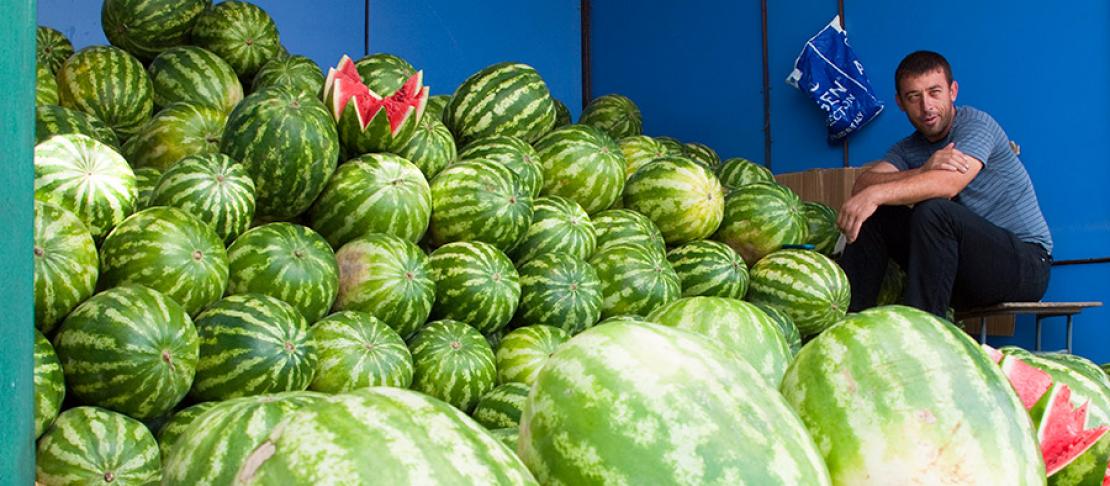In Central Asia, small wallets pay a big price for climate change impacts

by Caity Peterson
Recent research coming out of Central Asia tells a woefully familiar story: when it comes to climate change impacts, it’s the little guys who take the hardest knocks.
Farmers in Central Asia and the Caucasus face some of the direst predictions for climate change of anywhere else in the world. Temperatures in Kazakhstan, Kyrgyzstan, Tajikistan and Uzbekistan are expected to rise by 3.7°C, well above the global average of 2.8°C. At high elevations this increase could be extreme, resulting in glacier reduction, increased evaporation, and a sudden scarcity of watering points in the surrounding rangelands. Regional precipitation will decrease by 3% and shift to the non-growing season, crop yield could decline by 5-30% by 2050, and grasslands may lose up to 30% productivity. More than half of all irrigated croplands in the region are already affected by high salinity, or water logging, or both. If it was dry here before, it’s about to get a lot drier.1
Number-blasting of this kind is commonplace in the climate science world, but rarely have such statistics been associated with a concrete price tag. How much will these changes actually cost farmers? To what extent will rural incomes be affected by climate change impacts on crop performance? Researchers at the International Center for Agricultural Research in the Dry Areas, ICARDA, have found that impact on farmer income is mediated by a number of factors. Nevertheless, socioeconomic status and agro-ecological indicators may play a big role in determining whether or not the ball will be played in a farmer’s favor.
In Kazakhstan, for example, it’s small scale farmers – especially females – with less access to extension services and technology that will likely experience the greatest income risk from climate change (up to a 30% decline in some areas). On the other hand, male farmers with larger-scale operations and access to services could experience a relatively positive income effect. The size of a farmer’s landholdings, however, may not be the only factor at play here. In Tajikistan the effect was opposite (farmers with large holdings experienced negative impacts while those with small holdings experienced positive impacts), and the difference was in the climate; negative effects were experienced by those farming in arid areas whereas positive effects were experienced by those in sub-humid areas.
What seems to be an almighty contradiction is only telling us that the effect of climate change on rural incomes is a highly local phenomenon. As with so many agro-ecosystem related questions, making generalizations is at best unreliable and at worst dangerously misinformed. The researchers are careful to note that social-economic status is only indicative as a factor in climate impact differences – there is as yet no quantitative relationship between the two. Nevertheless, this fact has exciting implications for the direction of future research.
Other factors that need further investigation are the repercussions of a potential drop in water availability as a result of changes in temperature and precipitation. In an area that is for the most part already quite arid, a drop in water supply could be a dire turn of events. It could also change the outcome of some of the crop and income models playing into ICARDA’s analyses. Concerns about current water management practices make research into water-saving policies and technologies an urgent priority for the region.
What makes ICARDA’s work in Central Asia and the Caucasus so interesting is that it brings together a trio of crop simulation and climate models, farm household surveys, and economic risk programming modeling to make its predictions. More importantly, these somewhat intangible computer simulations have finally been linked to something on which farmers and policymakers alike have always had a firm grasp: their purse strings. If the future plays out as projected in some areas, those who have less could end up with much less while those who have more could end up with even more. This possibility is an oft-ignored consequence of climate change impacts on agriculture: the exacerbation of social differentiation among smallholders and industrial farmers. As if farmers needed any more help to understand the reality of climate change impacts on their lives, they may now need to look no farther than their bank accounts.
***
The “Climate change and rural livelihoods” project, funded by the Asian Development Bank, is part of the greater CGIAR Research Program for Sustainable Agricultural Development in Central Asia and the Caucasus, which has been ongoing since 1998. For more information visit the CGIAR CAC website or contact t [dot] bremer [at] cgiar [dot] org (Tareq Bremer) or a [dot] aw-hassan [at] cgiar [dot] org (Aden Aw-Hassan).
Further reading:
Christmann S and Aw-Hassan A. New topics and high time pressure: Climate change challenges agricultural research in Central Asia and the Caucasus. International Center for Agricultural Research in the Dry Areas (ICARDA), Aleppo, Syria.
Caity Peterson is a visiting researcher based at the International Center for Tropical Agriculture (CIAT) in Colombia, working on CCAFS Theme 1: Adaptation to Progressive Climate Change.